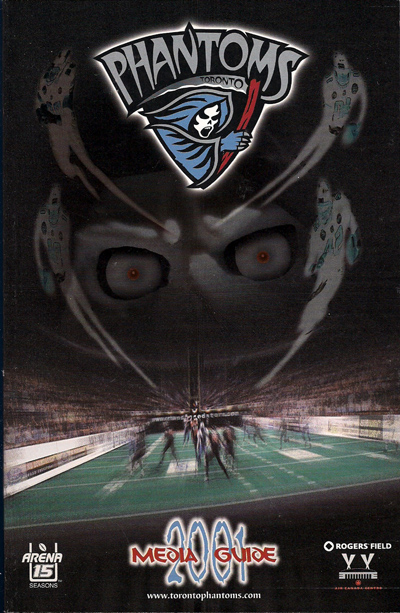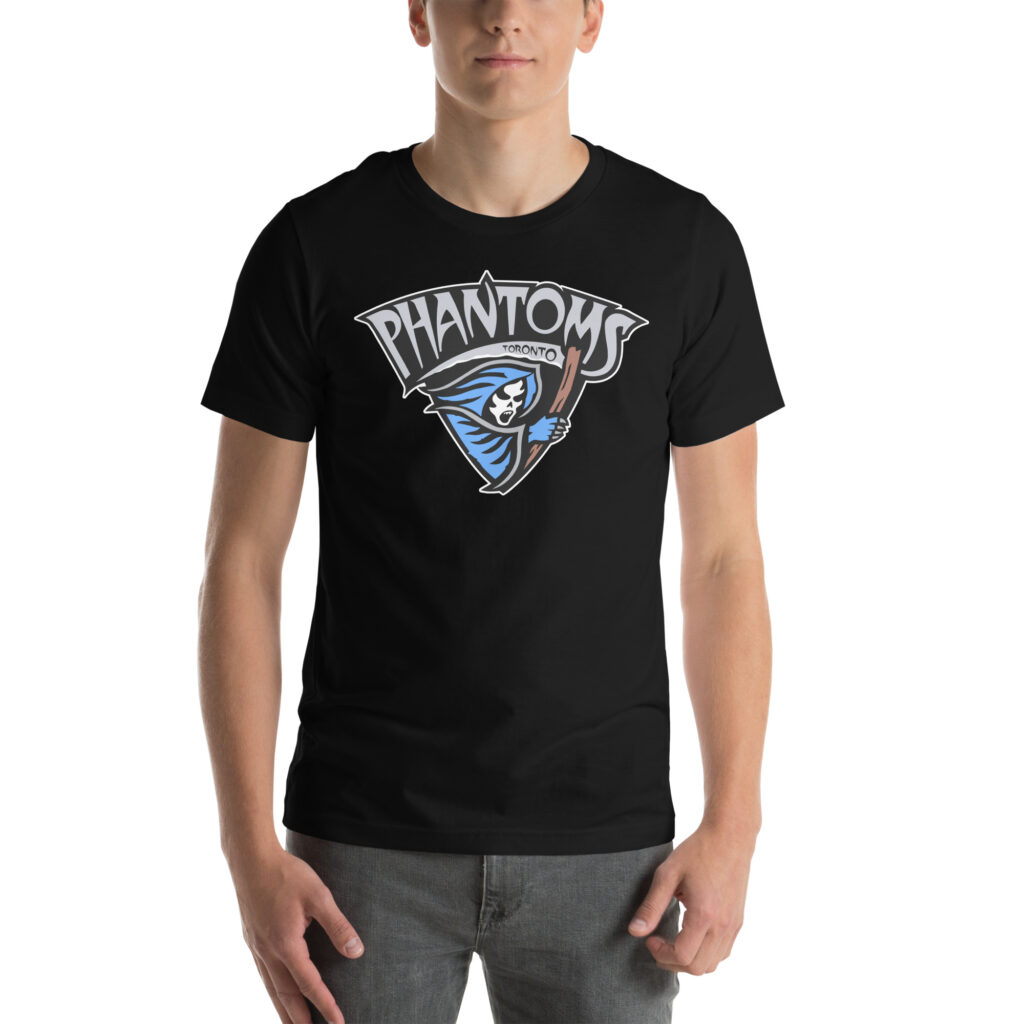Arena Football League (2001-2002)
Tombstone
Born: October 17, 2000 – The New England Sea Wolves relocate to Toronto
Folded: September 2002
First Game: April 14, 2001 (L 61-54 vs. Buffalo Destroyers)
Last Game: July 18, 2002 (L 66-65 vs. New York Dragons)
Arena Bowl Championships: None
Arena
Air Canada Centre (17,100)12002 Arena Football League Record & Fact Book
Opened: 1999
Marketing
Team Colors: Black, Blue & Silver22002 Arena Football League Record & Fact Book
Ownership
Owner: Rogers Communications, et al.
FWIL FAVORITE
Toronto Phantoms
Logo T-Shirt
Of the countless Arena Football League teams, the Phantoms were the only one ever placed outside the United States. The Phantoms reportedly derived their name (but almost certainly not their logo!) from a manufacturer of women’s undergarments run by one of the team’s co-owners.
Also now available in silver, and white from Royal Retros
Background
On September 1st, 2000, Rogers Communications moved into professional sports ownership. The Canadian communications giant agreed to purchase 80% of the Toronto Blue Jays from Interbrew SA for $112 million. Rogers brought in former Toronto Sun publisher and CEO Paul Godfrey as the new Blue Jays President.
Meanwhile, Godfrey’s 27-year old son Rob Godfrey had sports ambitions of his own for Toronto. Godfrey and partners Ronnie Strasser and Keith Stein approached Arena Football League Commissioner David Baker in the summer of 2000 about the possibility of acquiring an AFL franchise for Toronto. Baker and his staff brokered the purchase of the New England Sea Wolves franchise for a reported price of approximately $7 million.
The Godfrey group’s purchase of the Sea Wolves received preliminary approval during league meetings at Arena Bowl XIV in August 2000. In early September, just as Rogers Communications bought the Blue Jays and Paul Godfrey took over the baseball club, Rogers also agreed to take a reported 51% majority stake in the Toronto Phantoms Football Limited Partnership. League officials and team execs introduced the Phantoms to Toronto at a press conference on October 17th, 2000. The announcement marked the first expansion of the Arena Football League outside the United States.
Panty Raid on the CFL
The Phantoms derived their name from a not-so-frightening source. Co-founder and minority partner Ronnie Strasser’s Toronto-based Phantom Industries was North America’s third largest manufacturer of women’s hosiery. Nevertheless, at least two people found Arena Football’s arrival in Toronto quite terrifying: Canadian Football League President Jeff Giles and Sherwood Schwarz, owner of the CFL’s struggling Toronto Argonauts. The Phantoms’ April-August schedule would overlap by two months the the Argos’ June-November outdoor season at Skydome. The two clubs would spent the winter months competing for the same local sponsor and season ticket accounts.
“I’m disappointed in the arena league because they said they wouldn’t do anything to harm or hurt the CFL,” Giles told Canadian Press in October 2000. “I think it is extremely naive to say that it (arena football) won’t hurt the CFL.”
2001 Debut Season
The Phantoms debuted at the Air Canada Centre on April 14th, 2001 with a 61-54 loss to the Buffalo Destroyers in front of an announced crowd of 10,023. The Toronto Star did few favors for the new franchise with its inaugural game coverage. Under the headline “Obscure Phantoms Kick Off”, Star beat writer Mark Harding used his story lead to cast doubt on the club’s attendance figures.
On the turf, the 2001 Phantoms posted an 8-6 record. Former University of Southern California quarterback Pat O’Hara, a two-time Arena Bowl winner with the Orlando Predators, led the team offensively, along with Offensive Specialist Damian Harrell, a Sea Wolves holdover. In the postseason, the Phantoms defeated their divisional rivals the New York Dragons in the Wild Card round before falling to the Nashville Kats in the AFL quarterfinal.
Any fears that the Phantoms would sink the Toronto Argonauts at the box office proved unfounded. The Sherwood Schwarz-era was a dark time for Toronto Argos fans, but the damage was largely self-inflicted. The Phantoms claimed attendance of 48,448 over seven home dates. The average of 6,921 fans per game ranked 16th out of 18 AFL franchises in 2001.
Demise
The 2002 Phantoms got off to a 5-5 start before dropping their final four games to finish at 5-9 and out of playoff contention. Attendance remained flat at 6,975, which ranked 14th in the 16-team league. In September 2002, the Phantoms owners dropped out of the league after 24 months.
Phantoms President Rob Gregory explained the decision in a no-longer available online Sports Business Journal article in September 2002. Factors in the Phantoms’ demise included larger than expected losses, the unfavorable exchange rate between the Canadian and U.S. dollar and the impending move of the Arena Football League’s 2003 season to a February (instead of April) start to accommodate the league’s new national American broadcast television contract with NBC. The Air Canada Centre already had three winter season tenants in the NHL’s Maple Leafs, NBA’s Raptors and the Toronto Rock of the National Lacrosse League. Attractive home dates would have been scarce as the AFL became a winter/spring sport to appease its broadcast partner.
The Arena Football League never returned to Canada after the failure of the Phantoms. The original AFL folded and filed for bankruptcy in 2009 after 22 seasons. A group of former AFL owners subsequently bought the name out of bankruptcy in November 2009. A modestly budgeted, lower profile version of the league re-opened in the spring of 2010.
Toronto Phantoms Shop
[auction-nudge tool=”listings”]
Toronto Phantoms Video
The Phantoms host the New York Dragons in a first round playoff game at the Air Canada Centre. July 27, 2001.
Links
##


